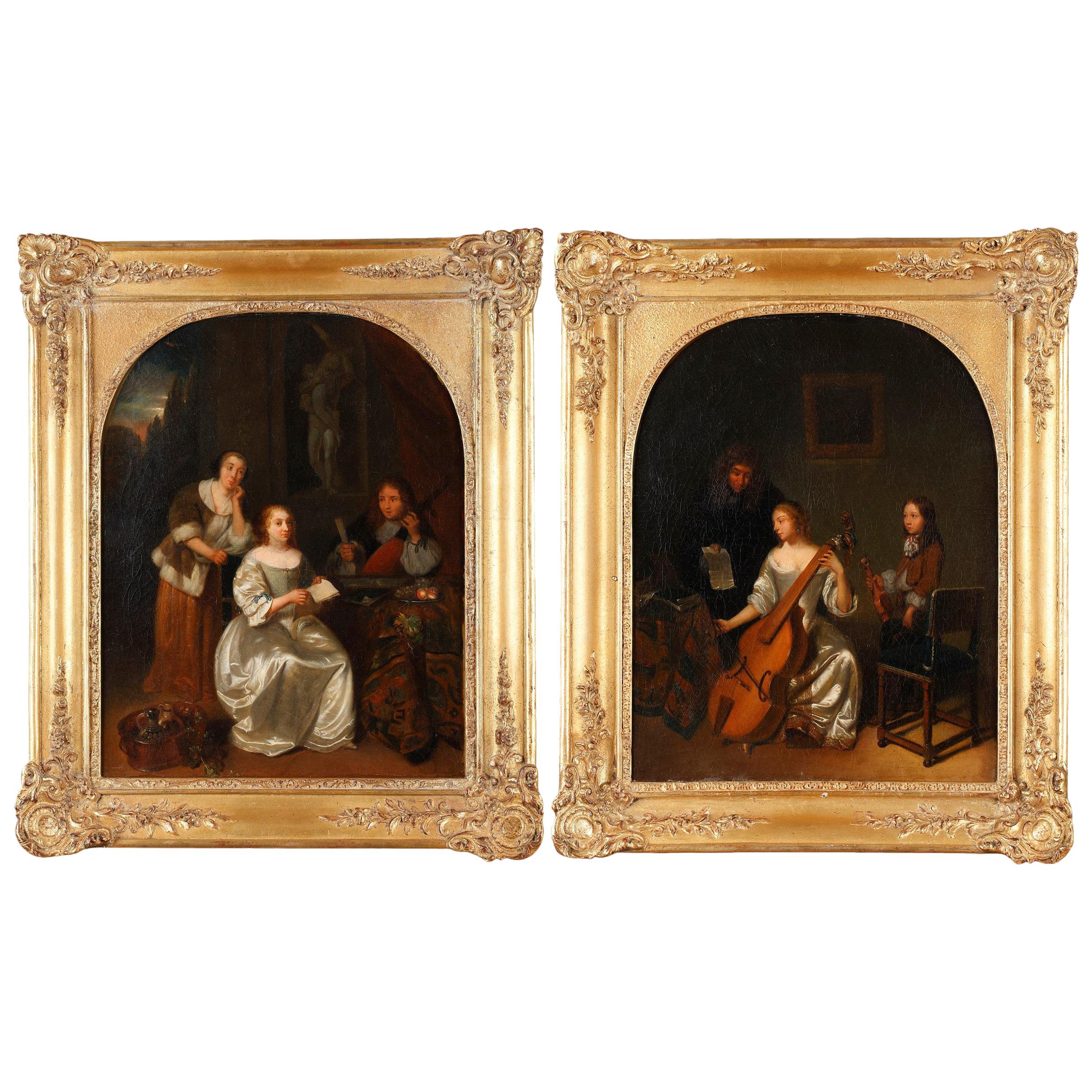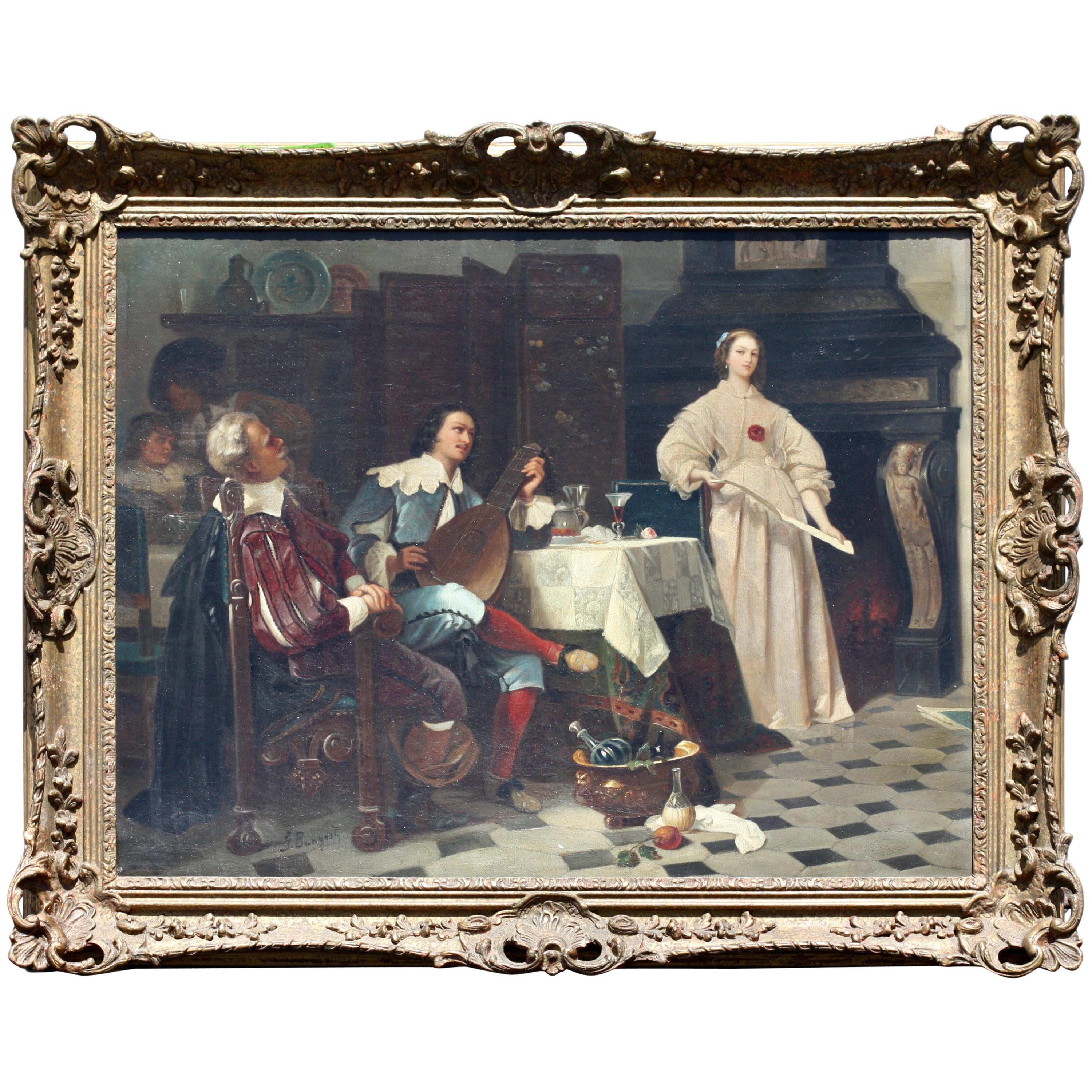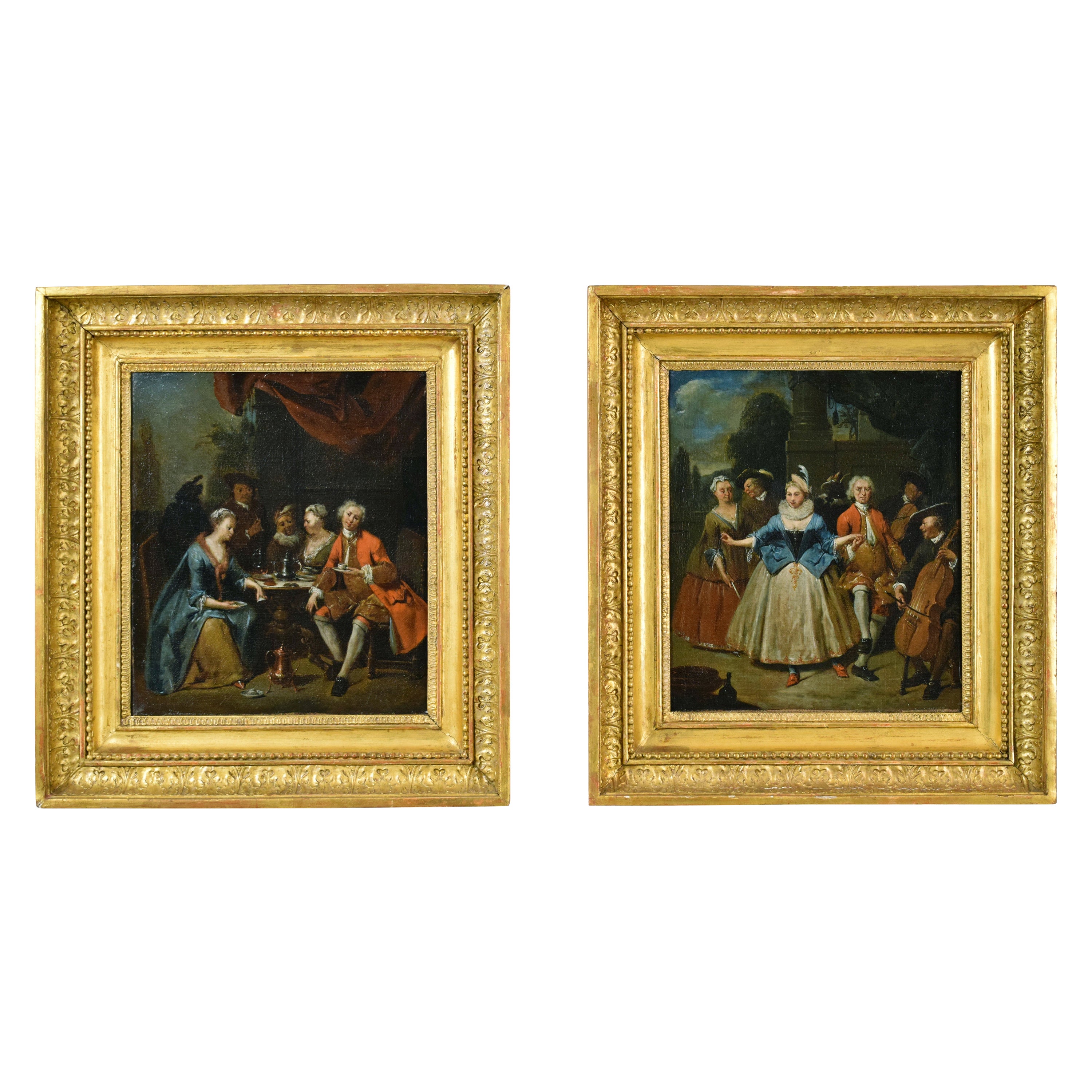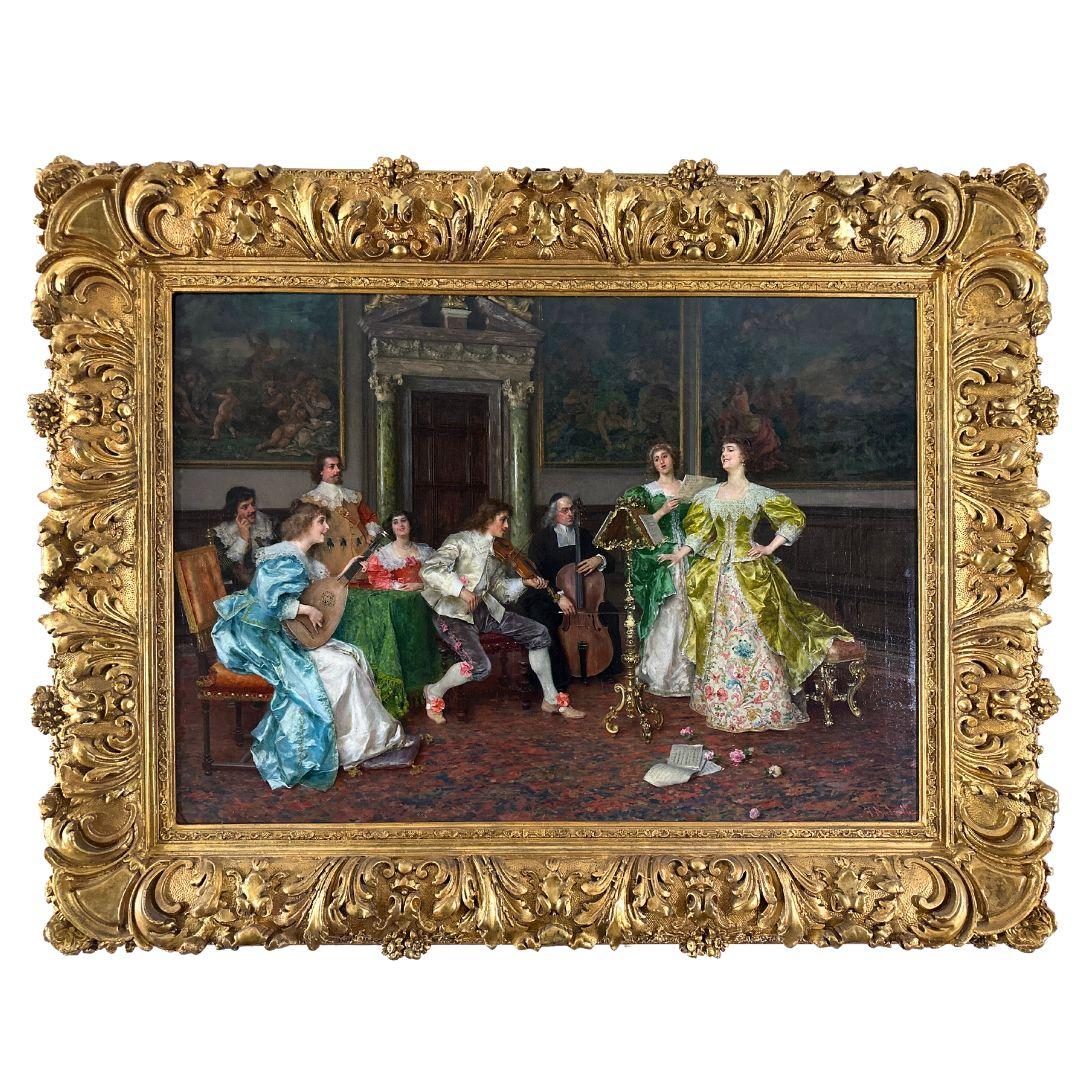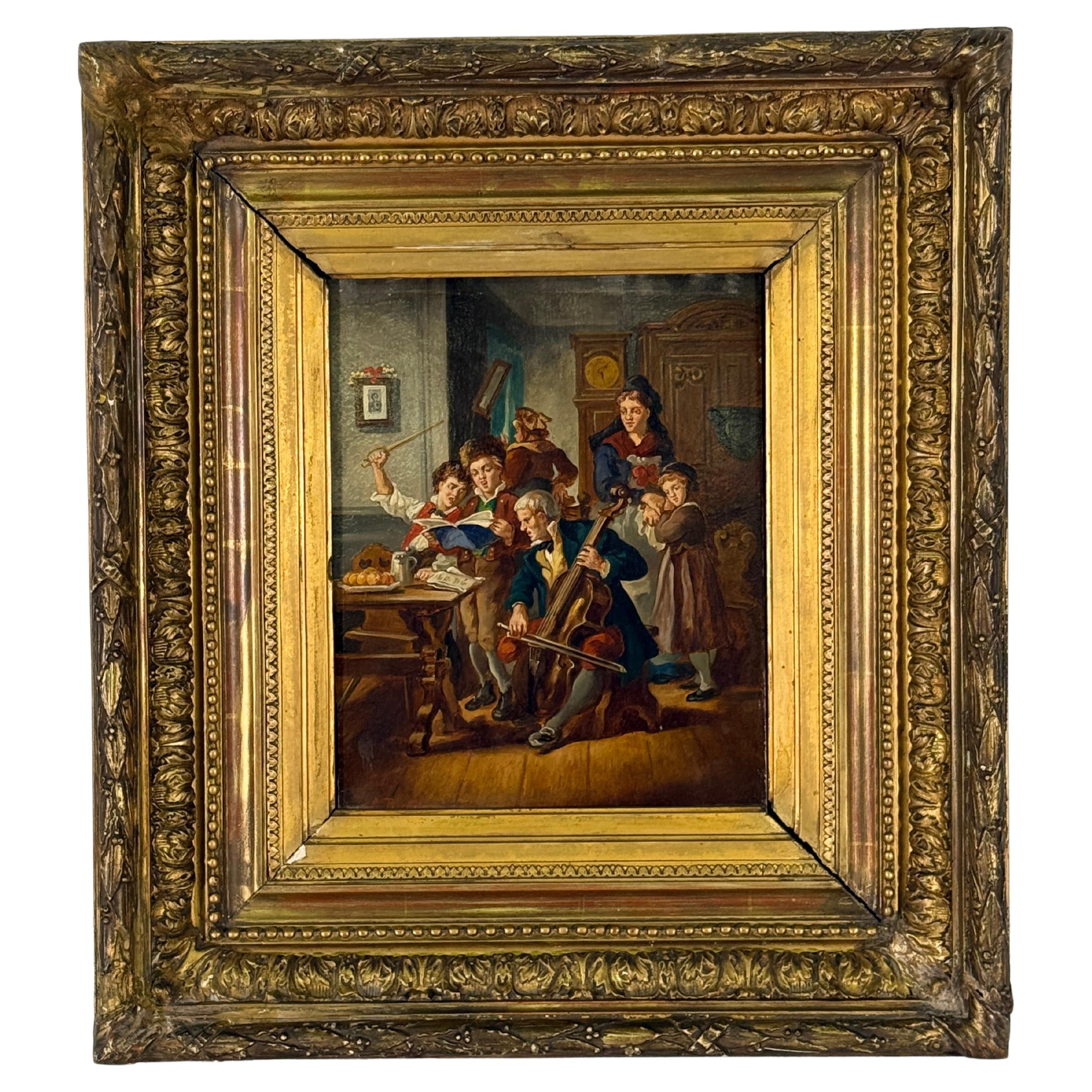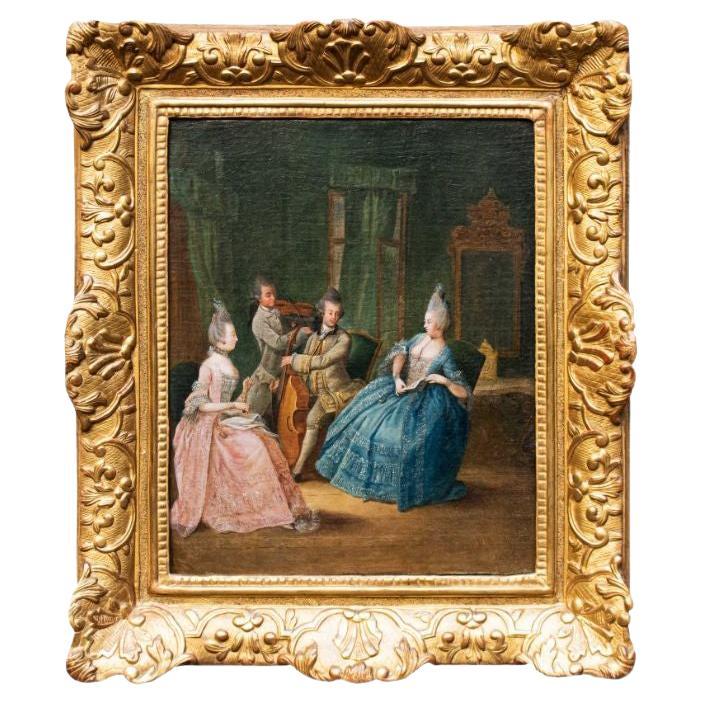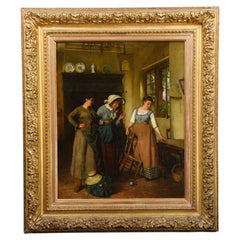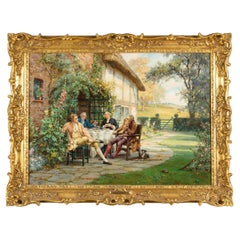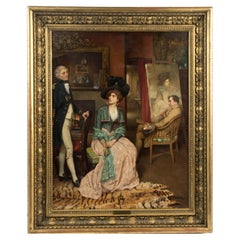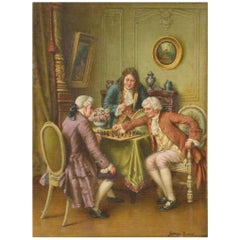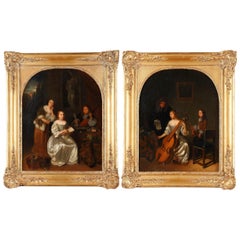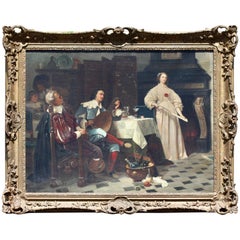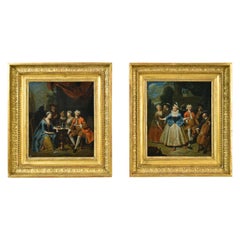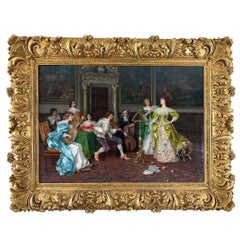Items Similar to Elegant Musical Party in an Interior’ Attributed to Gillis Van Tilborgh
Want more images or videos?
Request additional images or videos from the seller
1 of 6
Elegant Musical Party in an Interior’ Attributed to Gillis Van Tilborgh
$113,040.80
£81,750
€96,311.44
CA$156,623.68
A$169,960.58
CHF 90,064.13
MX$2,084,483.70
NOK 1,114,537.09
SEK 1,053,178.55
DKK 719,012.98
About the Item
An Elegant Musical Party in an Interior’ attributed to Gillis van Tilborgh, oil on canvas depicting a Dutch genre scene with figures dressed in rich silk clothing, fine lace ruffs and fichu collars grouped round musicians playing a clavichord, a fiddle and a flute, some couples holding hands or sitting close together and a baby playing on the floor, with a plaque reading ‘Gerard Terburg 1608-1681’, the reverse with a chalk notation ‘Ld Hesketh’. Dutch, circa 1870.
Provenance: George, 3rd Earl of Pomfret (1768-1830), or his brother The Hon. Thomas Fermor, later 4th Earl of Pomfret (1770-1833), Easton Neston.
Thence by descent, Lord Hesketh, Easton Neston.
His Sale, Sotheby’s London, 17-19 May 2005, lot 82. Private Collection.
Literature: George Baker, ‘The History and Antiquities of the County of Northamptonshire’ 1838, part IV, p.145, as ‘Flemish Musical Party, Palamedes’, and hanging in the Music Room; Philips & MacConnal, 1919, p.1, item 4, as ‘Given to Gerard Terburgh’ and hanging in the Picture Hall.
Historical Significance. ‘Genre scenes such as these merrymaking tavern interiors were invented during the seventeenth century in the Low Countries. The newly proclaimed Dutch Republic sought independence from their Spanish rulers, establishing their own trade routes around the world. The treasures, spices and goods brought back to Amsterdam made it the busiest port in Europe and made the Dutch Republic the wealthiest nation on Earth. This unprecedented influx of wealth resulted in an endless appetite for fine art. Famous artists such as Rembrandt, Rubens, Teniers & Frans Hals made their fortune in response to the market, and for the first time, paintings were made on speculation rather than by commission. Genre scenes such as the present painting belonged to this new category as they appealed to a great number of wealthy citizens. Imbued with a moral message of love and lust, the familiar setting of a tavern interior, with people dressed just like you, made them an incredibly exciting and vivid experience to behold. Dutch seventeenth century paintings are particularly celebrated for their realism, famously described as “the art of describing.” In fact, the tavern scene is depicted with such attention to detail that Van Tilborgh has included other ‘real’ paintings on the wall in the background, including a rendition of Peter Paul Rubens’ Angelica and the Hermit, which Van Tilborgh would have personally seen in Rubens’ home in Antwerp.
Gillis van Tilborgh, taught by the most famous Flemish painter of the 17th century, David Teniers, became a member of the important Saint Luke Painters’ Guild in Brussels in 1654, when he set up his own successful studio. Specialising in group portraits and genre scenes, Van Tilborgh’s use of colour is lively, with reds and blues reminiscent of Teniers. His success brought him to England around 1670, taking commissions from English aristocracy.
Easton Neston, the seat of the Hesketh-Fermor family for nearly 500 years, was home to an unrivalled collection of works of art, dating from as far back as the Tudor period.
Framed Height 53 ½ inches Width 64 inches
Canvas Height 39 ¼ inches Width 50 inches.
- Dimensions:Height: 53.5 in (135.89 cm)Width: 64 in (162.56 cm)Depth: 1 in (2.54 cm)
- Materials and Techniques:
- Place of Origin:
- Period:
- Date of Manufacture:circa 1870
- Condition:Wear consistent with age and use.
- Seller Location:Lymington, GB
- Reference Number:1stDibs: LU973030929962
About the Seller
5.0
Recognized Seller
These prestigious sellers are industry leaders and represent the highest echelon for item quality and design.
Gold Seller
Premium sellers maintaining a 4.3+ rating and 24-hour response times
Established in 1982
1stDibs seller since 2013
134 sales on 1stDibs
Typical response time: 2 hours
Associations
LAPADA - The Association of Arts & Antiques Dealers
- ShippingRetrieving quote...Shipping from: Lymington, United Kingdom
- Return Policy
Authenticity Guarantee
In the unlikely event there’s an issue with an item’s authenticity, contact us within 1 year for a full refund. DetailsMoney-Back Guarantee
If your item is not as described, is damaged in transit, or does not arrive, contact us within 7 days for a full refund. Details24-Hour Cancellation
You have a 24-hour grace period in which to reconsider your purchase, with no questions asked.Vetted Professional Sellers
Our world-class sellers must adhere to strict standards for service and quality, maintaining the integrity of our listings.Price-Match Guarantee
If you find that a seller listed the same item for a lower price elsewhere, we’ll match it.Trusted Global Delivery
Our best-in-class carrier network provides specialized shipping options worldwide, including custom delivery.More From This Seller
View AllA Genre Interior Scene Painted by Jules Ruinart de Brimont (1838-1898)
Located in Lymington, Hampshire
This fine oil on canvas shows three female generations of the same family, grandmother, mother and daughter, in the interior of a country cottage. The youngest of the three women see...
Category
Antique 19th Century French Paintings
Materials
Canvas, Paint
‘Tea at the Vicarage’ by Margaret Dovaston, Dated 1952
By Margaret Dovaston
Located in Lymington, Hampshire
‘Tea at the Vicarage’ by Margaret Dovaston, dated 1952, an oil painting showing four gentlemen having an earnest conversation over a cup of tea on a terrace outside a cottage garden, Margaret Dovaston, dated 1952. English.
Margaret Isabel Dovaston (1884 – 1954) was a British artist who became particularly well known for her historical genre scenes, often depicting groups in Georgian costume. In the course of her education, she was taught by Thomas William Cole at the Ealing School of Art and Arthur Stockdale Cope at the South Kensington School of Art. Her crowning achievement was winning a five-year scholarship the to the Royal Academy Schools (1903-1908) where she won many medals. She exhibited at the Royal Academy (1908 and 1910) and helped set up The Ealing Art...
Category
Vintage 1950s English Mid-Century Modern Paintings
Materials
Paint
Admiral Viscount Nelson and Lady Emma Hamilton in the Studio of George Romney
Located in Lymington, Hampshire
This oil painting shows the fictional scene of Emma, Lady Hamilton meeting Lord Nelson in Romney’s studio. She is seated for her portrait wearing a full pink skirt under a tightly f...
Category
Antique 1880s English Paintings
Materials
Paint
Antique Oil Painting by Georges Dupre
By Georges Dupre
Located in Lymington, Hampshire
Oil on board with two men playing chess in an 18th century interior while a third smokes a clay pipe, in the original frame, signed.
Category
Antique 19th Century French Paintings
Materials
Paint
An oil painting of circus performers by Emilio Grau Sala
By Emilio Grau Sala
Located in Lymington, Hampshire
An oil painting of circus performers by Emilio Grau Sala, featuring circus performers, including a dancer in a white tutu on a painted blue stage, ...
Category
Late 20th Century Spanish Paintings
Materials
Paint
Thomas Whitcombe ‘Flora’
Located in Lymington, Hampshire
Thomas Whitcombe: ‘Flora’, this oil on canvas shows the action, within a gilt frame with a panel reading ‘British Frigate “Flora”, 36 guns commanded b...
Category
Antique 1780s English Paintings
Materials
Canvas, Paint
$25,926
You May Also Like
Painting "The Music Lesson", French School, Circa 1840
Located in PARIS, FR
Charming pair of paintings representing young women in well-off interiors during their music lesson, one illustrating a singing lesson and the other a Cello lesson.
The theme of the music lesson...
Category
Antique 1840s French Paintings
Materials
Canvas
$8,428 Sale Price / set
78% Off
Belgian School, 19th Century Oil on canvas "A musical interlude"
Located in West Palm Beach, FL
Belgian School, 19th century
Oil on canvas
"A musical interlude"
Signed (lower left)
Measures: 21 x 27 1/8 in (53.3 x 68.8cm).
Category
Antique 19th Century Paintings
Materials
Canvas
18th Century, Flemish Painting Banquet and Dance Scene by Jan Baptist Lambrecht
Located in IT
18th century, Flemish Painting with Banquet and Dance scene by Jan Baptist Lambrechts
Oil on canvas, Measurements: only the canvas cm H 34 x W 30; frames cm H 49,5 x W 45 x D 8
Thes...
Category
Antique Early 18th Century Belgian Louis XIV Paintings
Materials
Canvas
"Music in the Parlor" 19th century antique realism oil painting on, Signed
Located in Jacksonville, FL
The painting is signed
Description:
Frederico Andreotti (1847-1930) was an Italian painter celebrated for his exquisite genre scenes and historical subjects. Born in Florence, Andreo...
Category
19th Century Academic Figurative Paintings
Materials
Canvas, Oil
19th Century (late) Painting Family Gathering with Cellist
Located in Scottsdale, AZ
19th Century (late) Painting Family Gathering with Cellist
Beautiful Condition, Purchased in France.
Age appropriate wear, see detailed photos or message us with questions.
Category
Antique Early 19th Century French Napoleon III Paintings
Materials
Wood, Paint
18th Century Concert scene Painting Oil on Canvas by Daniel Nikolaus Chodowiecki
Located in Milan, IT
Daniel Nikolaus Chodowiecki (Danzig, 1726 - Berlin, 1801)
Interior scene with concert
Oil on canvas, 42 X 34 cm
With frame 57 x 49 x 6 cm
Already attributed to Pietro Longhi, the ...
Category
Antique Mid-18th Century German Paintings
Materials
Canvas
More Ways To Browse
Ruff Collar
George Baker
Used Clavichord
Leon Brunin
Leonora Sisto
Lester Goldman
Lolo Painting
Louis Icart Oil Paintings
Ludovico Della Rocca
M Q Rothwell
Malcah Zeldis
Marc R Rubin
Marco Fine Furniture
Marek Halter
Mexican Religious Paintings
Michael J Whitehand
Miniature Portrait Josephine
Naked Women Oil Painting
